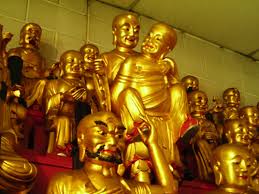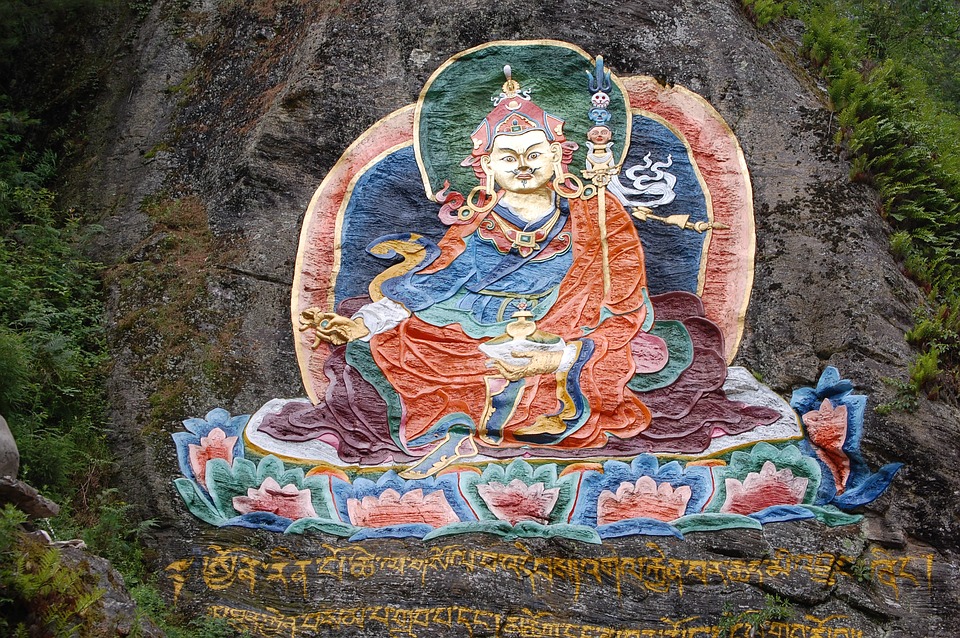Around the same time as Christianity began to spread across the Near East and the Occident, a new movement began to flourish within traditional Buddhism, which was called the Great Wheel – the Mahayana, to distinguish the Theravada School, which was disparagingly referred to as Hinayana, or Lesser Wheel. Understood within the context of the age in India at that time, the path of salvation of the fledgling Mahayana School was more open to laymen and laywomen. While the situation was a lot more complicated, a major reason why a new Mahayana movement sprang into existence was due to the Theravadin ideal of the monastic monk as the highest embodiment of the religion. Some thought it was time for something new.
 Embodied as the highest concept of selflessness, compassion, and love is the Bodhisattva, or Wisdom (Bodhi) Being (Sattva). Anyone, literally, can be a Bodhisattva, because a Bodhisattva has not reached Nirvana – he or she has postponed Enlightenment to lead all other sentient beings to Nirvana before he or she reaches it. It is an almost paradoxical concept, but it has been celebrated as the most selfless ideal within the Mahayana context.
Embodied as the highest concept of selflessness, compassion, and love is the Bodhisattva, or Wisdom (Bodhi) Being (Sattva). Anyone, literally, can be a Bodhisattva, because a Bodhisattva has not reached Nirvana – he or she has postponed Enlightenment to lead all other sentient beings to Nirvana before he or she reaches it. It is an almost paradoxical concept, but it has been celebrated as the most selfless ideal within the Mahayana context.
Mahayana Buddhism also reintroduced mystical and theological concepts into religion, making Buddhism an even more diverse faith. Paramount to the pantheon of spiritual powers are celestial Buddhas, Mahasattvas (“Great Beings” – literally super Bodhisattvas) such as Avalokiteshvara, Lord of Compassion, and Manjusri, Lord of Wisdom.
Another important concept introduced was that of sunyata or Emptiness.
It is not a void of nothingness, rather, it is a web of interconnectedness, where “All is one and one is All”. It was a concept introduced to refute the delusions of a separate enduring ego and to emphasize how everything in the cosmos is connected. Mahayana Buddhism itself split into several different schools with differing opinions on the nature of Emptiness (the most prominent were the Yogacara and Madhymaka, although there were many more), as well as on the prominence of the various celestial Buddhas. The Pure Land School, for example, focused on an intensely devotional practice to Amitabha, Buddha of Infinite Light, while the Shingon School focused on the esoteric theology of a quasi-theistic Buddha, Vairocana. Nevertheless, the focus of all the new schools still remained from the Four Noble Truths, Dependent Genesis, and the Eightfold Path, although now there were new choices and new paths to follow.
The Influence of Mayahana Buddhism in China, Japan, and North Korea
Some include Vajrayana, or the Tibetan School of Buddhism, as part of the Great Wheel, but it in itself is so unique it has been rightly accorded its own classification – hence the three major schools, Theravada, Mahayana, and Vajrayana. While all three schools are gaining prominence in the West as not simply a religion, but a religion with a very deep understanding of psychology, something that many other religions lack, Mahayana may come to be one of the most popular schools yet.





